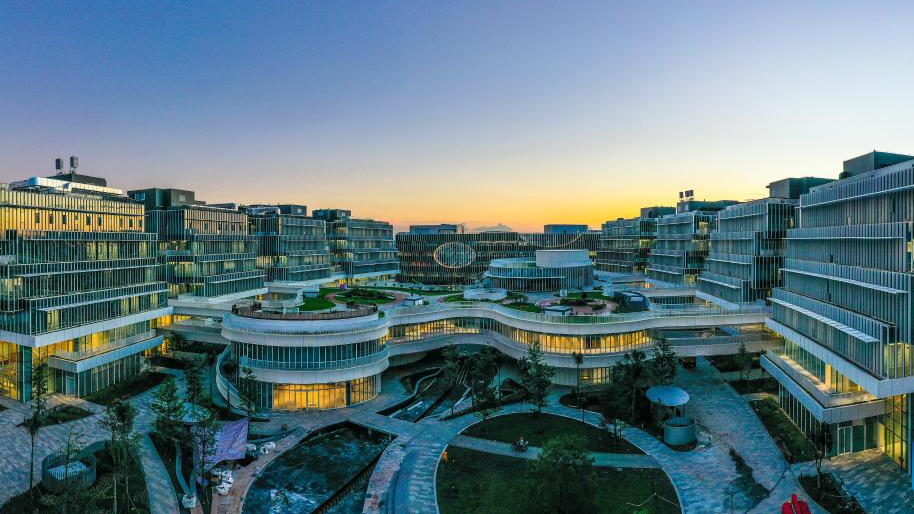Big, bright spot in global economic landscape
Silver lining of China's recovery and growth offers hope amid dark clouds worldwide
A confluence of high inflation, low growth and rising financial fragility may be painting a gloomy picture of the world, but the steady recovery of China's economy is proving to be a silver lining, experts said.
The US economy has reported economic contraction on an annualized basis for two consecutive quarters this year. This, they noted, rendered the world's largest economy into a so-called technical recession.
In contrast, the Chinese economy grew 2.5 percent year-on-year in the first half in spite of unexpected shocks from Omicron outbreaks and geopolitical tensions.
In July, the country's industrial output expanded by 3.8 percent year-on-year, generally stable compared with 3.9 percent in June, pointing to a continuous momentum in economic recovery, according to the National Bureau of Statistics.
What is even more encouraging is that China's growth story is expected to continue. International investment banks and asset managers said they expect China's economic growth to accelerate to about 4 percent in the second half and above 3 percent for the whole year.
Notably, such growth would not be a consequence of aggressive stimulus campaigns that could turn out to be heavy debt burdens in the long term.
Instead, China's growth in the second half, experts said, will be underpinned by reviving demand in its strong domestic market, moderate stimulus measures, and efforts for high-quality development, including innovation and green development.
The country's cautiousness in launching aggressive stimulus and its commitment to high-quality development even amid difficulties will set the stage for steady economic growth in the coming couple of years, injecting robust momentum into the world economy, they said.

Technicians check diagnostic reagents at a biotech company's R&D center in Chongqing on March 29. China is expected to see an acceleration of tech progress over the next five years. [Photo/Xinhua]
"The Chinese economy has started to recover from the COVID-19-related restrictions. This might be one of the very few bright spots in the global economy right now," said Wang Qian, Vanguard's Asia-Pacific chief economist.
Wang said the US-based investment company expects China's economic growth to accelerate to about 4 percent year-on-year in the second half, compared with 2.5 percent in the first half.
The country's full-year economic growth may stand between 3 percent and 4 percent, she said, thanks to accelerated infrastructure investment, recovering consumer activity and accommodative macroeconomic policies.
Wang, however, said China's economic recovery is not without risks amid a global economic slowdown, which could mean weaker demand for China's exports of manufactured goods. Moreover, the economy also faces the challenges of COVID-19 uncertainties and a real estate downturn.
Data from the General Administration of Customs showed that China's export growth in dollar terms remained buoyant in July at 18 percent year-on-year, demonstrating the resilience of China's industrial chain.
The growth, nevertheless, could fall to single-digit numbers in the coming months due to a higher comparison basis, souring global demand and fading high export prices, meaning that the country should avoid counting exports as the main driver of economic recovery, experts said.
They further said efforts to boost domestic demand, especially fixed-asset investment, are instead expected to bring the advantage of China's vast domestic market into further play and act as the key for the Chinese economy to register stable growth amid intensified external uncertainties.
"Given the growing recession risks facing the world economy, especially in Europe and the United States, China's economy may feel the pressures of weakening external demand," said Cheng Shi, chief economist at ICBC International.
"Effectively expanding (domestic) investment will be crucial for China to fend off the external risks," Cheng said, adding that fiscal policy may play a major role in boosting investment while monetary policy is expected to continue structural support for businesses and residents' living conditions.
The Political Bureau of the Communist Party of China Central Committee, the Party's core leadership, had decided at a recent meeting that macroeconomic policies should play a proactive role in boosting demand, as part of the nation's efforts to achieve the best possible results of economic performance.
An executive meeting of the State Council, China's Cabinet, has further specified that the key role of effective investment in boosting economic recovery shall be brought into play.
The State Council has also pledged efforts to accelerate central government budgetary investments, urge local governments to expedite the use of special bonds and make good use of policy-based and development-oriented financial instruments to support infrastructure projects in several fields, including transportation, energy, logistics, agriculture and rural areas.
NBS data showed China's fixed-asset investment growth stood at 5.7 percent year-on-year in the first seven months of the year, led by infrastructure investment growth of 7.4 percent and manufacturing investment growth of 9.9 percent.
Zhu Haibin, JPMorgan's chief China economist, said the country's fixed-asset investment may grow by around 6 percent year-on-year in 2022 as a key driving force of China's economic growth, which, he added, is expected to come in at 3.2 percent for the whole year and 3.8 percent in the second half.
As a strong foothold for growth stabilization, China's infrastructure investment is likely to register high single-digit growth of between 8 percent and 10 percent year-on-year in 2022, Zhu said, a notable acceleration from 0.4 percent last year.
Manufacturing investment may also sustain a strong expansion of about 10 percent this year, which will combine with buoyed growth in infrastructure investment to offset weak real estate development investment that might register full-year negative growth.
Meanwhile, China's consumption growth is expected to gradually recover in the second half, thanks to reviving services sector activity amid better containment of COVID-19 and policy measures to boost consumer spending, said Hu Yifan, head of macroeconomics for Asia-Pacific at UBS Global Wealth Management.
Local governments across China have recently accelerated measures to boost consumption. A growing number of cities, including Beijing, Shanghai and Shenzhen, Guangdong province, have unveiled shopping events or offered coupons to boost consumption in sectors like catering and tourism.
Experts said the stimulus measures rolled out by China so far are moderate in strength, marked by emphasis on economic restructuring that will help consolidate the basis for longer-term growth and high-quality development.
Notably, high-tech sectors and green industries have acted as an emerging driving force for growth. During the January-July period, the added value of high-tech manufacturing increased by 9 percent year-on-year, higher than the 3.5 percent of total industrial output. In July, the production of new energy vehicles and solar cells surged by 112.7 percent and 33.9 percent year-on-year, respectively, according to the NBS.
David Wang, chief China economist at Credit Suisse, said he expects China to continue making progress toward green transition and technological innovation in the coming years, elevating the country's efficiency of leveraging productive factors to generate economic growth.
Investment in green infrastructure may continue to accelerate, Wang said, especially in the realms of sustainable electricity sources such as water, wind and solar.
Meanwhile, with the government stressing self-reliance in science and technology and improvements in resource allocation, the country is expected to see a modest acceleration in technological progress over the next five years.
China's growth in total factor productivity, or TFP, per year may stand at around 2.2 percent over the next five years, helping offset the decelerating forces, including shrinking working-age labor, he said.
The TFP is a measure of productive efficiency-it measures how much output can be produced from a certain amount of aggregate inputs, reflecting the driving force of technological progress in economic growth.
Nevertheless, some experts still called for additional stimulus measures to iron out short-term downward pressures as China's economic recovery showed signs of softening in July and the impact of policy support could abate late this year.
The country's fixed-asset investment growth of 5.7 percent in the first seven months marks a slowdown from 6.1 percent a month earlier, accompanied by a weakening in the expansion of retail sales from 3.1 percent year-on-year in June to 2.7 percent in July.
To sustain brisk infrastructure investment and therefore stable economic growth in the fourth quarter, it is necessary for China to launch additional fiscal stimulus to supplement the funding capacity of local governments, Zhu from JPMorgan said.
This is because the proceeds from local government special bonds issued this year-a key funding source of infrastructure investment-are expected to be used up around August, meaning that governmental funding support for infrastructure projects could falter in the fourth quarter. During the January-July period, local governments issued 3.47 trillion yuan ($510.89 billion) in new special bonds, official data showed.
Photos
Related Stories
Copyright © 2022 People's Daily Online. All Rights Reserved.









